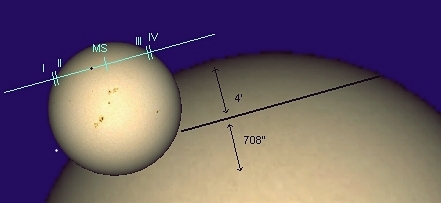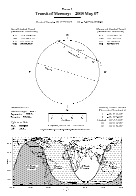
- - text and links as of last publication - -

On Wednesday, May, 7th 2003 occurs one of this year's major event: Mercury will transit in front of Sun's disk. Unluckily, Americas, USA and Australia will not be favoured as Europe, Asia and Africa (except Western Africa) will be. A Mercury transit is not that rare compared to a Venus transit. On average, there are 13 Mercury transits each century (last took place in 1999) as next year Venus transit will be the first since 122 years. Mercury transit is an important event anyway and an event to see
All Mercury transits occur either in May (about May, 8th) or in November (about November, 10th). It is at these times that the planet is crossing Earth's orbit planes. Such times are called the nodes of Mercury's orbit. Transits occur when Mercury is at its nodes, and in inferior conjunction, that is when the planet is between Sun and Earth. When transit occurs in November, Mercury is at perihelion (with a disk is 10"); in May Mercury is at aphelion (12"). May transits are twice less numerous than those of November and occur each 13 or 33 years. November transits occurs each 7, 13 or 33 years. Next Mercury transit will take place in 2006 (November), then in 2016 (May) and 2019 (November) and no more transit will occur before 2032
Technically, a transit comprises five moments: two ingress contacts (contact I and II), two egress contacts (III and IV) and the central point (greatest transit; the planet passes at the nearest of the Sun's center, this moment is also called "minimum separation"). The two ingress and egress contacts are understood like this: contact I is the moment when planet's external limb comes in contact with Sun' external limb. It's the external tangency. Contact IV, at the opposite, is the external tangency, when planet's last external limb is leaving Sun's limb. Contact II is the internal tangency: planet has already progressed on the solar disk and its limb is leaving solar limb as the planet begins its course in front of the Sun. At the opposite, contact III is the internal tangency when the planet is beginning to leave definitively the disk; planet's limb arrives to contact of Sun's limb. Internal tangent contacts (II et III) are precisely the moments when, after or before the so-called "black drop effect", the disk of the planet is completely encircled with light; before, limbs are in touch; planetary disk is not dissociated from sun's limb. During 20 to 30 seconds, planet's dark disk is linked, drop-shaped, to solar limb. Contacts II and III are measured when planetay disk is dissociating, only (contact II) or when it stops being dissociated (contact III). It is usually these contacts which are measured. Contact I and IV are not easily observable as the planet is still -or again- in the glare of the Sun. Using an H-alpha filter, these contacts may be seen however as the planet is seen silhouetting on the prominences or on Sun's chromosphere. The planet then crosses slowly the solar disk. . The minimum separation is the center of the course: planet is at its nearest of the center of the solar disk (and farthest from the limb)
 | click to an illustration of May, 7th, 2003 Mercury transit |
This year, the transit will be visible in its entirety in Europe, Asia and Africa (except Western Africa). In Japan, Australia and New-Zealand the show will be interrupted by sunset. In Western Africa, north-eastern America and north-east of South America, the end of the transit will be visible only, once Sun rised. Most of USA will be deprived of the transit (except Alaska where the transit is partially visible and northeasternmost parts), as will be western part of South America and eastern Pacific Ocean. UT transit times, for the center of the Earth, are given below. Observing times, for such or such place, may vary by several minutes compared to these times. Mercury will take 5h 20 mn to transit. The minimum separation (center of the transit, distance to the center of the solar disk) is 708 arc-seconds (or 11' 48"), i.e. relatively near the solar edge. Local times should be found on the Internet (try at the Fred Espenak's site. For weather forecasts, see at NOAA National Weather Service. Link below leads to a map of the transit and of the visibility zones. Map is courtesy Fred Espenak, NASA/Goddard Space Flight Center (Fred Espenak's Eclipse Home Page)
| contact I | 05:12:56 |
| contact II | 05:17:24 |
| minimum separation | 07:52:23 |
| contact III | 10:27:19 |
| contact IV | 10:31:46 |
 | click to a factsheet of the Mercury transit May, 7th, 2003 |
As far as observation techniques are concerned, think first that OBSERVING SUN IS DANGEROUS. About solar observing dangers, see the tutorial "Observing the Sun". USE APPROPRIATE SAFE SOLAR OBSERVING TECHNIQUES (see safe Sun observation techniques at tutorial "Observing the Sun"). You may use either the projection technique (though at aphelion, Mercury is however small -12"), method by which the Sun's image is projected on a screen, or use appropriate solar filters instrument's aperture. About magnification, a site advises 50x to 100x. Some institutions will gather data (see, e.g. at Sky & Telescope (in English) or the site Eclipse Home Page, by Fred Espenak (in English). Sites will be webcasting the event: see a series of links at SpaceWeather.com (in English)
Observation Reports: live webcams sites for the Mercury transit were diversely favoured by the weather. Best images (however narrowed ones) were to be found on the site of the Swedish Solar Telescope (Canary Islands) -The Institute for Solar Physics, www.solarphysics.kva.se, The Royal Swedish Academy of Sciences. They have too an interesting link with fine pictures at Soho exploring the Sun
Website Manager: G. Guichard, site 'Amateur Astronomy,' http://stars5.6te.net. Page Editor: G. Guichard. last edited: 12/28/2010. contact us at ggwebsites@outlook.com